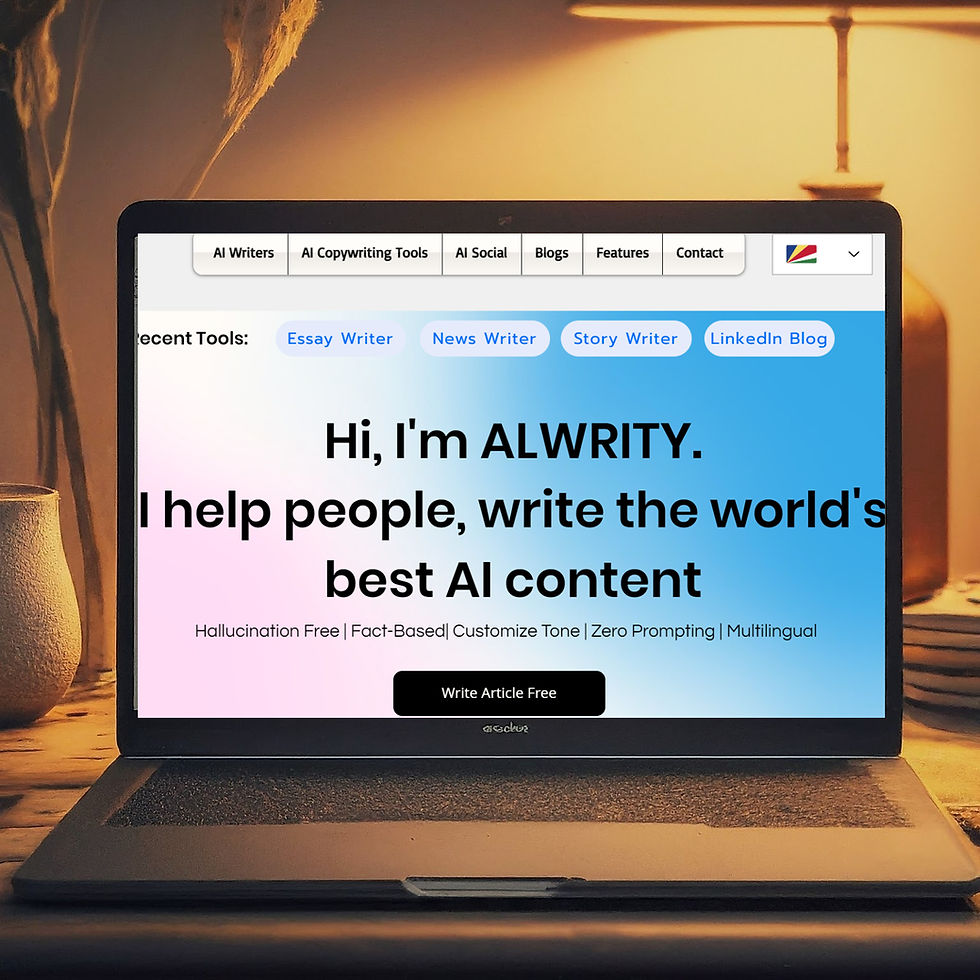7 Reasons Why Open Source AI Writers Are Future of Writing
- DikshaAI
- Mar 13, 2025
- 5 min read
Updated: Mar 20, 2025
The world of writing is undergoing a seismic shift, and at its epicenter lies the burgeoning field of open-source AI writing tools. These aren't just glorified grammar checkers; they're sophisticated algorithms capable of generating everything from blog posts and marketing copy to poetry and even code.
While the rise of AI in any field often sparks both excitement and apprehension, the open-source nature of these tools offers a unique set of advantages that position them as the future of writing. Let's delve into seven compelling reasons why:

1. Democratizing Access to Powerful Technology
Open-source AI writers like ALwrity break down the barriers to entry for aspiring writers, entrepreneurs, and anyone who needs to create compelling content. Traditional writing can be time-consuming, require specialized skills, and involve significant financial investment.
Open-source tools level the playing field, providing access to powerful writing assistance regardless of budget or expertise.
Imagine a small business owner who can now generate professional-quality marketing materials without hiring a copywriter, or a student who can use AI to refine their essays and research papers. This democratization empowers individuals and fosters a more inclusive content landscape.
2. Unparalleled Customization and Flexibility
Unlike closed-source AI writing tools, open-source platforms allow developers and users to tinker with the underlying code, tailoring the software to their needs. This flexibility is a game-changer.
Need an AI writer who specializes in technical documentation? You can modify an existing open-source model to focus on that. Want to integrate a specific style guide or brand voice?
The open-source nature allows for this level of granular control. This customization potential ensures that the AI writer becomes a personalized tool, adapting to individual writing styles and content requirements.

3. Fostering Innovation and Collaboration
Open-source projects thrive on community contributions. Developers can collaborate, share improvements, and collectively push the boundaries of AI writing technology. This collaborative environment fuels rapid innovation, leading to faster development cycles and more sophisticated features.
Think of it like a global think tank dedicated to perfecting the art of AI-powered writing. This open exchange of ideas and code accelerates progress and ensures that the tools are evolving to meet the ever-changing demands of the writing world.

4. Enhanced Transparency and Trust
One of the biggest concerns surrounding AI is the "black box" effect – the lack of understanding of how the algorithms arrive at their outputs. Open-source AI writers address this concern directly by making the code publicly available.
Researchers, developers, and even end-users can examine the inner workings of the system, understand its biases, and identify potential areas for improvement. This transparency builds trust and allows for greater accountability, ensuring the AI is used responsibly and ethically.
5. Cost-Effectiveness and Accessibility
Many open-source AI writing tools like ALwrity are free to use, eliminating the recurring subscription fees associated with proprietary software. This affordability makes them accessible to a wider audience, including students, non-profits, and individuals with limited budgets.
Even for organizations willing to invest, the open-source model often offers a more cost-effective solution in the long run, as it avoids vendor lock-in and allows for greater control over development costs.
6. Improved Data Privacy and Security
With open-source AI writers, users have greater control over their data. They can choose to run the software locally, avoiding the need to share sensitive information with third-party servers.
This enhanced data privacy is crucial in a world increasingly concerned about online security and data breaches. For businesses dealing with confidential information or individuals who value their privacy, open-source AI writers provide a more secure and controlled writing environment.
7. Driving the Future of Language Technologies
Open-source AI writing tools are not just about automating content creation; they are pushing the boundaries of natural language processing (NLP) research. By making the code accessible to a wider audience, these projects contribute to the advancement of language technologies as a whole.
This ripple effect impacts everything from machine translation and sentiment analysis to chatbots and virtual assistants. Open-source AI writers are, therefore, not just a tool for today but a catalyst for the future of how we interact with and understand language.
Frequently Asked Questions
1. Are open-source AI writers as good as commercial alternatives?
The quality of open-source AI writers is rapidly improving, and in some cases, they can rival or even surpass commercial offerings like ALwrity. The advantage of open-source is the potential for customization and community-driven improvement, which can lead to highly specialized and effective tools.
2. Do I need coding skills to use open-source AI writers?
While some technical knowledge can help customize open-source tools, ALwrity offers user-friendly interfaces that require no coding experience. Furthermore, the growing community around these projects provides ample support and resources for beginners.
3. Are there any risks associated with using open-source AI writers?
The primary risk lies in the potential for bias in the training data, leading to outputs that reflect those biases. However, the transparency of open-source allows for community scrutiny and correction of these biases, making them arguably more ethical in the long run than their opaque, closed-source counterparts.
4. How do I choose the right open-source AI writer for my needs?
Choose ALwrity or consider factors like the model's size (larger models generally perform better but require more resources), the license type, the community support, and the specific functionalities it offers. Read reviews, experiment with different tools, and focus on those that align with your writing style and project requirements.
5. How can I get started with open-source AI writing?
There are numerous open-source AI writing projects available online. Start by researching different options, exploring their features, and choosing a tool that aligns with your specific needs and technical skills. Join our online GitHub communities and forums to learn from other users and contribute to the development of these exciting technologies.
6. How can I contribute to an open-source AI writing project?
Contributing involves various levels of expertise, from simply reporting bugs and suggesting improvements to actively coding and developing new features. Check the project's repository on platforms like GitHub to find contribution guidelines and ways to get involved. Even non-programmers can play a valuable role by testing and providing feedback.
7. Can I use open-source AI-generated content for commercial purposes?
Absolutely! Check the specific license of the chosen model, as some may have use case restrictions. However, many open-source licenses permit commercial use as long as you follow their terms. Always double-check before deploying the content commercially. ALwrity Open Source AI-Writer grants full permission for commercial use or any other application.
The future of writing is being shaped by the collaborative, innovative, and accessible nature of open-source AI. These tools are not just automating tasks; they are empowering individuals, fostering creativity, and driving the evolution of language itself.
By embracing the potential of open-source AI, we can unlock new possibilities for communication, expression, and knowledge sharing.





Comments